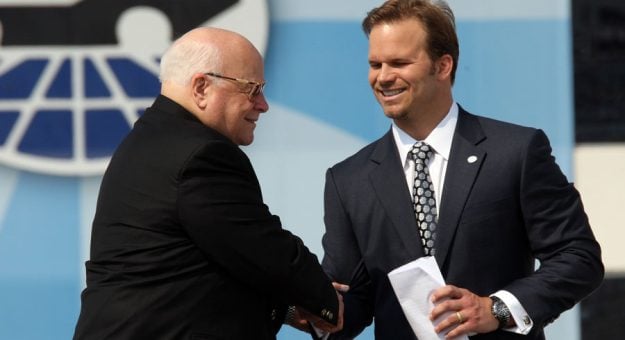WILLMETTE, Ill. — Motorsports is full of iconic characters. These individuals are the fabric of the sport. Their lives on and off the track shaped our history and guide our future.
Recently, racing lost several of its pioneers and this month we will examine their legacies.
O. Bruton Smith was the man, myth and legend. Born in Oakboro, N.C., he had a brief driving career that led him to the promotional side of racing. His first major venture was partnering with Curtis Turner to build Charlotte Motor Speedway.
In 1960, the facility hosted the inaugural Coca-Cola 600, which still is run each Memorial Day weekend.
The track filed for bankruptcy the following year due to construction debt. It continued to operate during a reorganization period under new management. Debts were repaid in full a few years later.
Being the businessman he was, Smith was able to regain majority ownership by purchasing shares in the track. In 1975, he took control and hired H.A. “Humpy” Wheeler as general manager of Charlotte Motor Speedway.
During this time, Smith entered the car business with is original dealerships located in Rockford, Ill. This led to the formation of Sonic Automotive, one of the nation’s largest automotive retailers with more than 100 locations.
Building beyond the typical was one of Smith’s hallmarks.
It did not matter if it had ever been done or how much it cost — he would just do it.
Speedway Motorsports eventually expanded its track portfolio to nine facilities with a combined seating capacity of more than 850,000. His list of motorsports facility developments is extensive and includes luxury suites, tiered grandstands, condominiums, office towers, dining restaurants, health clubs, naming rights, video boards, garage tours and four-lane drag strips.
The most innovative was the 1992 installation of permanent lighting system by Musco at Charlotte Motor Speedway. This led to nighttime NASCAR racing, which is considered the norm now with many primetime races on broadcast television.
Financial innovation was also a trademark. Speedway Motorsports went public in 1995 and became the first motorsports company to trade on the New York Stock Exchange. Presentations, led by attorney Lauri Eberhart, produced a successful investor road show.
The company went private in 2019 and Smith’s son, Marcus Smith, now runs the business.
Bruton Smith raised the bar for motorsports and did it with a style that only he could.
Bill Bader began operating Ohio’s Norwalk Raceway Park in the mid-1970s. His focus on the fans and participants was special. He paid attention to the little things and continually improved his drag-racing facility and the fan experience there.
His goal was to provide family entertainment at an affordable cost.
What better way to satisfy spectators than with “one pound of ice cream for a dollar.” This unique promotion has been running for decades and continues to lead to long lines at the concession stands.
Night Under Fire draws a standing-room-only crowd to Bader’s track, which is now known as Summit Racing Equipment Motorsports Park annually. Bill Bader Jr. carries on that strong tradition of taking care of customers.
The Deery family is well known in short-track racing circles.
Their legacy is deeply rooted in Rockford Speedway, located in Loves Park, Ill.
Hugh and Jody Deery were married after World War II and became involved in the track about a decade later. After Hugh Deery’s unexpected passing in 1984, Jody took over running the speedway. There were questions, but the family decided to manage it together.
They realized they were in the entertainment business, so racing was part of the equation but not the only show. Innovative promotions such as trailer races, penny gold rush and fireworks filled the bleachers at the quarter-mile asphalt track.
Jody’s entrepreneurial spirit and positive attitude were an inspiration for all.
Racing can be a family business and its icons prove that combination can work — focus on the details, respect your customers and look toward the future.
